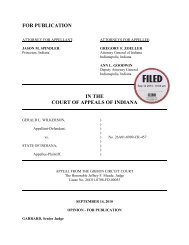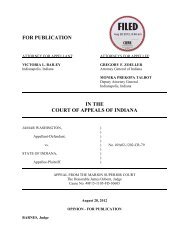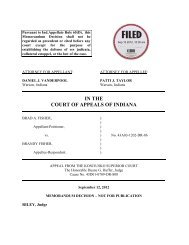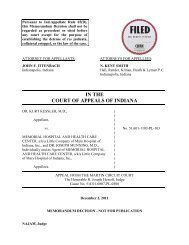Indiana State Health Improvement Plan (I-SHIP) - State of Indiana
Indiana State Health Improvement Plan (I-SHIP) - State of Indiana
Indiana State Health Improvement Plan (I-SHIP) - State of Indiana
Create successful ePaper yourself
Turn your PDF publications into a flip-book with our unique Google optimized e-Paper software.
Reduce Infant Mortality<br />
Hispanic/Latino or Hispanic/Latino population. The Infant Mortality Rate<br />
for Black non-Hispanic/Latino population is consistently higher each year<br />
than the state average, and even in 2007 when the Black non-<br />
Hispanic/Latino rate dropped from 18.1 to 15.7, it was still over twice as<br />
high as the White non-Hispanic / Latino rate in 2007. The percentage <strong>of</strong><br />
Black women receiving prenatal care in the first trimester decreased from<br />
68.2% in 2003 to 65.6 % in 2006. The Black premature birth rate in <strong>Indiana</strong><br />
between 2000 and 2005 has consistently increased, and is at a much higher<br />
percentage than the total premature percentage. From 2000 through 2002,<br />
the Black premature birth percentage was 18.1, before increasing to 18.5<br />
between 2003 through 2005. The Black low birth weight percentages have<br />
steadily increased every year from 13.3% in 2003 up to 14.4% in 2007.<br />
<strong>Indiana</strong> has seen a decreasing trend in smoking during pregnancy from<br />
19.1% in 2002 to 17.3% in 2006. However, 17.3% smoking in pregnant<br />
women is still too high and not acceptable. Fifty-one percent <strong>of</strong> all pregnant<br />
women in <strong>Indiana</strong> are on Medicaid at time <strong>of</strong> birth. Smoking rates among<br />
pregnant women on Medicaid have been found to be 1.5 times that for<br />
pregnant women not on Medicaid. In 2009, ISDH linked Medicaid patient<br />
data to 2007 vital record data. Results showed that an average <strong>of</strong> 27.7% <strong>of</strong><br />
all women delivering a live baby on Medicaid smoked during pregnancy in<br />
2007, compared to 17.3% for all pregnant women in <strong>Indiana</strong>. What was<br />
even more alarming was that for pregnant women on Medicaid 68 <strong>of</strong> 92<br />
counties had a smoking rates <strong>of</strong> 30% or greater and 13 counties had smoking<br />
rates <strong>of</strong> 40-49%. MCH will collaborate with the Office Medicaid Policy and<br />
<strong>Plan</strong>ning (OMPP), Medicaid Managed Care Organizations, the Tobacco<br />
Prevention and Cessation Commission at the Indian <strong>State</strong> Department <strong>of</strong><br />
<strong>Health</strong>, <strong>Indiana</strong> Tobacco Quitline, and other state and local partners to<br />
decrease smoking among pregnant women on Medicaid and all pregnant<br />
women.<br />
In 2009 and 2010, <strong>Indiana</strong> received a grade <strong>of</strong> D on the March <strong>of</strong> Dimes<br />
Premature Birth Report Card. In fall 2010, ISDH Maternal and Child <strong>Health</strong><br />
Division called together a group <strong>of</strong> health care providers, hospitals, health<br />
pr<strong>of</strong>essional organizations and concerned organizations to coordinate<br />
statewide systems and approaches to improve perinatal health outcomes.<br />
Focus areas include implementing preconception and interconception care,<br />
reducing perinatal smoking, instituting more standardized levels <strong>of</strong> obstetric<br />
and neonatal care and reducing prematurity.

















